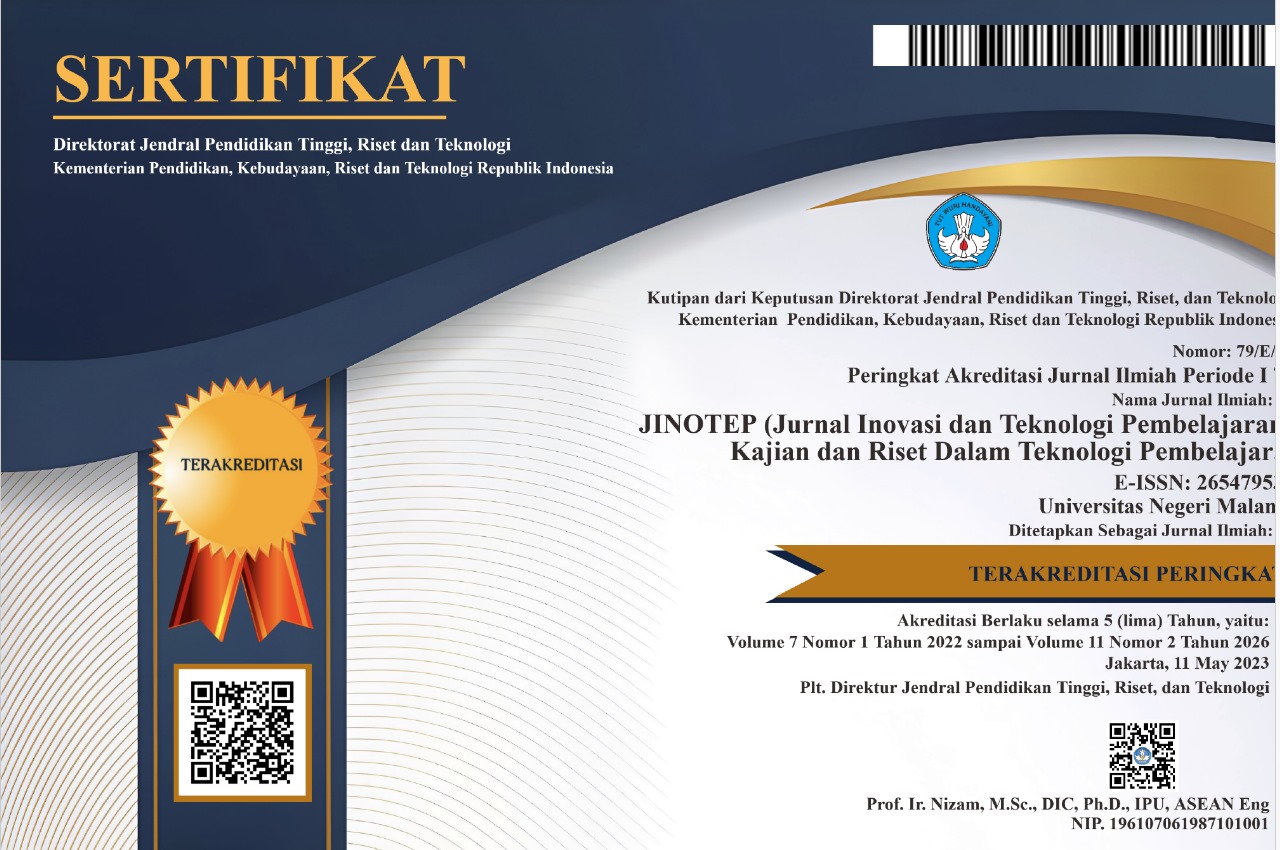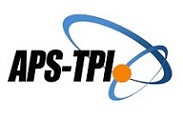Online Submissions
Already have a Username/Password for Jurnal Inovasi dan Teknologi Pembelajaran?
Go to Login
Need a Username/Password?
Go to Registration
Registration and login are required to submit items online and to check the status of current submissions.
Author Guidelines
We appreciate your decision to submit your paper to us. These instructions will ensure that we have everything necessary for your paper's peer review, production, and publication. Please take the time to carefully read and adhere to them, as doing so will ensure that your paper meets the journal's requirements.
1. All manuscript shall be written in Indonesian or English and submitted online via the journal website on http://journal2.um.ac.id/index.php/jinotep after register your account, if you encountered any difficulties, contact us through jinotep.fip@um.ac.id
2. The manuscript shall be formatted in one column using 11 pt Cambria font type, 1 space in the A4 paper, justify alignment in a maximum number of 15 pages (between 4.000-6.000 words included minimum 25 references). All manuscripts should be written in editable word processing software (e.g. Microsoft Word at least the 2007 version).
3. The title must be written in title case and should be in 16 pt font size with bold, center alignment, and a maximum of 15 words.
4. The author’s name shall be in 11 pt font size, centered alignment, and without an academic degree.
5. Correspondence’s address includes an email address, name, and address of correspondence’s affiliation or institution origin written in 10 pt font size and centered alignment.
6. The abstract should be written in both English and Indonesian in one paragraph consists a maximum of 160 words. Abstract contains the problem and research objectives; the method used; summary of the most important results and conclusions in the form of implications of the research results. Do not cite references in the abstract.
7. Keywords are any terms related to the general issue(s) of the articles and written minimum 3 and maximumly 5 keywords.
8. Systematic for research article are:
- The introduction section is used to describe the context of the problem under study in order to make it easier for the reader to understand why this research is important. The introduction must contain (sequentially) the background of the research problem raised, the reasons why the problem is important to research, a review of the previous literature (state of the art) which contains the identification of the best solutions that have been reported by previous research, then explain the limitations of the solutions. that has been reported, describe the research work carried out by the researcher, describe what is new that makes it different from the solutions that have been carried out by other studies. At the end of the introduction, the purpose of the study should be stated. Then the author must state clearly what the contribution of the research he did. The introduction must be written in 1.000-1.250 words.
- The method section contains the research design, research subjects, instruments used, data collection procedures, and data analysis presented in paragraphs and would be better if visualized in the form of flowcharts. We strongly emphasize that the authors clearly describe the methods section to make it easier for readers and other researchers to re-examine what is reported. The methods section is written in 400-700 words. For review articles, we strongly recommend authors use standard methods such as the PRISMA method which is widely used by the global community. So that it is more clear and transparent the database used to search for referral sources, the process of selecting referral sources, the deadline for the reference period to be published. The type of coding and data analysis used should also be described. For experimental research, it is highly emphasized to conduct testing using at least a quasi-experimental method. Researchers must explain the variables studied, both dependent and independent variables. We also emphasize the use of certain statistical tests in the testing process in order to strengthen the arguments in the process of drawing conclusions. In addition, the experimental procedure must be explained in detail so that it can be reproduced by other researchers who want to retest or use the method in other study contexts. For experimental research involving animals and humans must be accompanied by applicable ethical standards. To avoid ethical violations in reporting research results, we recommend not implicitly displaying photos of human faces, real names of respondents, and names of research locations, unless the researcher has written permission to present them. For development research, the author must clearly state the development model used, then the stages of development and testing process at least on a small class scale. This means that the research is emphasized until the usefulness and impact are tested, even if only in small classes (minimum sample of 30). In addition, it is necessary to test the impact using statistical tests. As for survey research, the author must explain how the sample selection method, sample size, clarity of the target population is. We strongly recommend that survey data use a proportionate percentage of the total population. In addition, in the data analysis process, authors are required to create high-quality data visualizations, not using screenshots of raw data (eg google form results). In addition, it is recommended to use statistical tests if the survey is intended to test a theory
- The results section contains the most important and essential research findings obtained from research data and related to the hypothesis or research objectives. The results can be in the form of data in the form of tables, images, or text narratives. To make it easier for readers to present the results, they can be sorted using subheadings according to the number of objectives and research questions. Present the result data without the data analysis process. If the data is from the results of software analysis such as SPSS, then the author must create a new table with the data obtained from the results, not copy and paste from the tables in SPSS. The results section is written in 800-1.000 words.
The discussion section contains the interpretation of the research findings that have been presented in the results section. The discussion section is very important, so the author must be able to give meaning to each of the findings produced. The author can also review findings outside of the main findings in the results section. However, it must be ensured that the discussion is correlated with the data in the results section. There should be no repetition of data in the discussion section, it is enough to interpret each finding in a qualitative analysis. Next, compare the previous findings with the findings produced by the authors. Perform analysis both when the results are mutually supportive or contradictory. Be careful not to pop up statements that don't relate to the resulting data. It is also not permitted to mention new terminology and terms that have not been mentioned in the previous section. In addition, it is not allowed to speculate on possible interpretations based on imagination that have nothing to do with research data. The discussion section is written in 850-1.000 words. In the discussion section, it is recommended to increase references from international journals. Reduce or avoid references from book sources. Presentation of the discussion section in the form of paragraphs. Each paragraph contains one main idea that is supported by supporting ideas. Each paragraph consists of at least three sentences that are complete, easy to read and grammatically correct. Especially in the discussion section, we recommend citing a minimum of 15 references from journals or proceedings that have DOI. The last paragraph in the discussion section should explain practical recommendations for scientific development, goals for improving the quality of learning, and other practical goals for readers.
- The conclusion section is in the form of answers to hypotheses and or research objectives in the form of research findings in the form of theories, postulates, formulas, rules, models, methods, media, and prototypes. Conclusions must be strengthened by the data that has been presented in the results section. but not rewritten at the conclusion. In addition, it must contain the limitations of the study as well as suggestions regarding further research ideas. Conclusions are presented in one paragraph. The concluding part is written in 150-180 words.
- Acknowledgment (Optional), Recognize those who helped in the research, especially funding supporter of your research. Include individuals who have assisted you in your study: Advisors, Financial supporters, or may another supporter, i.e. Proofreaders, Typists, and Suppliers, who may have given materials. Do not acknowledge one of the author's names.
- Conflict of Interest (Optional), Authors must disclose possible conflicts of interest to the journal. Any financial or non-financial relationship that could influence an author's objectivity is a conflict of interest. When relevant, authors must report these. Patent or stock ownership, company board participation, advisory board membership, and company consultancy or speaker's fees can all lead to conflicts of interest. Conflicts of interest do not prevent publishing. At submission, writers must indicate no conflict of interest. The corresponding author must review this policy with all authors and disclose all relevant commercial and other relationships with the submission.
- References, The list of references must actually be quoted in the article content and vice versa those quoted in the article content must really be included in the list of references. All references referred to in the text of the article must be listed in the Bibliography section. Writing bibliography and citations in the APA 7th edition style is recommended using the Mendeley application. The minimum number of references is 25 which contains a minimum of 80% from academic journal sources and a maximum of 20% from non-journals such as books, proceedings or other research reports. All references published within the last 10 years. It would be better if only using the last 5 years. The use of references from personal websites and blogs is not recommended. We strongly recommend using only references to journal articles and proceedings that have a DOI to make it easier for readers to trace the source of the reference. Therefore, if there is a reference that does not have a DOI number, we recommend replacing it. Except for references to major theories published without DOI. The reference section is written in 500-700 words.
9. Each title part shall be written in different types (all title part and subpart shall be written in bold or italic bold) and not in numbering format:
- HEADING 1 (CAPITALIZED ALL FONT, BOLD, LEFT-ALIGNMENT, 11 pts)
- Heading 2 (Title case, bold, left-alignment, 11 pts)
- Heading 3 (Title case, italic bold, left-alignment, 11 pts)
10. Table: table shall be clearly identified using the number and title above the table in bold font, 11 pt font, center alignment. The table shall be positioned in left-right alignment. The first letter in the table shall be capitalized, except phrases. The table’s data shall be written in a single space, 10 pt font. The table shall be presented only in a horizontal line and shall be mentioned in the paragraph.
11. Figure: The figure shall be presented in average to high resolution and identified using number and title under the figure and written in bold font 10pt center alignment. Figure shall be mentioned in the paragraph.
12. Citation and Reference are written according to the APA (American Psychological Association) 7th edition style, see: http://www.apastyle.org/; https://apastyle.apa.org/style-grammar-guidelines; https://apastyle.apa.org/instructional-aids. The references shall be ordered based on alphabetical and chronological order. We recommend using a reference manager application such as Mendeley, EndNote, or Zotero. Below is the example of References written according to the APA 6th edition style.
- Lorenzo, G., Newbutt, N., & Lorenzo-Lledó, A. (2022). Global trends in the application of virtual reality for people with autism spectrum disorders: conceptual, intellectual and the social structure of scientific production. Journal of Computers in Education, 9(2), 225-260. https://doi.org/10.1007/s40692-021-00202-y →Journal
- Louhab, F. E., Bahnasse, A., Bensalah, F., Khiat, A., Khiat, Y., & Talea, M. (2020). Novel approach for adaptive flipped classroom based on learning management system. Education and Information Technologies, 25(2), 755-773. https://doi.org/10.1007/s10639-019-09994-0 →Journal
- Mayer, R. E. (2017). Using multimedia for e‐learning. Journal of Computer Assisted Learning, 33(5), 403-423. https://doi.org/10.1111/jcal.12197. →Jurnal
- Ningsih, S. (2020). Persepsi Mahasiswa Terhadap Pembelajaran Daring Pada Masa Pandemi Covid-19. JINOTEP (Jurnal Inovasi Dan Teknologi Pembelajaran): Kajian Dan Riset Dalam Teknologi Pembelajaran, 7(2), 124-132. https://doi.org/10.17977/um031v7i22020p124. →Journal
- Rasheed, R. A., Kamsin, A., & Abdullah, N. A. (2020). Challenges in the online component of blended learning: A systematic review. Computers & Education, 144, 103701. https://doi.org/10.1016/j.compedu.2019.103701. →Journal
- Setyosari, P. (2010). Metode penelitian dan pengembangan. Jakarta: kencana. →Book
- Ulfa, S., Fattawi, I., Surahman, E., & Yusuke, H. (2019, October). Investigating Learners' Perception of Learning Analytics Dashboard to Improve Learning Interaction in Online Learning System. In 2019 5th International Conference on Education and Technology (ICET) (pp. 49-54). IEEE. https://doi.org/ 10.1109/ICET48172.2019.8987229. →Proceeding
13. All issues regarding permission of citation or software utilization during the process of paper or any issues regarding Intellectual Property Rights related to the author including its legal consequences will be the responsibility of the author.
14. The Board is authorized to reject a manuscript based on peer reviewer advice and make necessary changes or adjustments related to language properties without altering the substance. Substance editing would be consulted with the author first.
15. All Indonesian language manuscripts that accepted after the peer review process will be requested to be translated into English.
16. All manuscripts submitted will not be in charge(free of charge). Only selected papers that are guaranteed to be published will be charged for publication cost (IDR 200.000) starting for Volume 1 No. 1 2014.
17. All manuscripts submitted will not be in charge (free of charge). Only selected papers that are guaranteed to be published will be charged for publication cost (IDR 500.000) starting submission articles from July 8th 2023. However, article with first author from other country or all authors form other country will be FREE OF CHARGE.
The guideline and manuscript template in Bahasa Indonesia version can be downloaded here
While the guideline and manuscript template in English version can be downloaded here
Submission Preparation Checklist
As part of the submission process, authors are required to check off their submission's compliance with all of the following items, and submissions may be returned to authors that do not adhere to these guidelines.
- The submission has not been previously published, nor is it before another journal for consideration (or an explanation has been provided in Comments to the Editor).
- The submission file is in OpenOffice, Microsoft Word, RTF, or WordPerfect document file format.
- Where available, URLs for the references have been provided.
- The text is single-spaced; uses a 11-point font; employs italics, rather than underlining (except with URL addresses); and all illustrations, figures, and tables are placed within the text at the appropriate points, rather than at the end.
- The text adheres to the stylistic and bibliographic requirements outlined in the Author Guidelines, which is found in About the Journal.
- If submitting to a peer-reviewed section of the journal, the instructions in Ensuring a Blind Review have been followed.
Copyright Notice
Jurnal Inovasi dan Teknologi Pembelajaran allows readers to read, download, copy, distribute, print, search, or link to the full texts of its articles and allow readers to use them for any other lawful purpose. The journal allows the author(s) to hold the copyright without restrictions. Finally, the journal allows the author(s) to retain publishing rights without restrictions
- Authors are allowed to archive their submitted article in an open access repository
- Authors are allowed to archive the final published article in an open access repository with an acknowledgment of its initial publication in this journal

This work (http://journal2.um.ac.id/index.php/jinotep/index) is licensed under a Creative Commons Attribution-ShareAlike 4.0 International License.
Privacy Statement
The names and email addresses entered in this journal site will be used exclusively for the stated purposes of this journal and will not be made available for any other purpose or to any other party.
Author Fees
This journal charges the following author fees.
Article Submission: 0.00 (IDR)
Authors are not required to pay an Article Submission Fee, but if the article will publish author should pay cost as part of the submission process to contribute to review costs.
Article Publication: 1000000.00 (IDR)
If the paper is accepted for publication, you will be asked to pay an Article Publication Fee to cover publication costs. The fee covers DOI registration for each paper. The payment process via JINOTEP Virtual Account.
Based on the financial policy of State University of Malang, all submitted articles to the Sinta 3 Journal at UM as of July 8 2023 has a publication fee of 1.000.000 (IDR)
- All Indonesian Authors: IDR 1.000,000
- First author or all authors form other country: FREE OF CHARGE
======================================================================
Jurnal Inovasi dan Teknologi Pembelajaran published by Universitas Negeri Malang in collaboration with the Asosiasi Program Studi Teknologi Pendidikan Indonesia (APS TPI) and Ikatan Profesi Teknologi Pendidikan Indonesia (IPTPI) with a MoU.
Publisher Address:
Educational Technology Laboratorium, Building D5, 1st Floor
Faculty of Education, Universitas Negeri Malang
Semarang St. No. 5, Malang City, East Java Province, Postal Code 65145
Email: jinotep.fip@um.ac.id
======================================================================

JINOTEP is licensed under a Creative Commons Attribution-ShareAlike 4.0 International License.
JINOTEP Statistics (Since July 13th, 2020)


.png)




.png)
1.png)
1.png)
4.png)
2.png)
1.png)
1.png)
.png)


_3.png)





1.png)
.png)